Shrines / Wile E. Coyote (American Animated Character)
Last Updated:21/09/2023
Character
Wile E. Coyote
“[Wile E. Coyote is] a strong secondary character and for maximum potential should always be teamed with the Road Runner. Boys ages 3 to 7 really relate to the slapstick humor and quirky inventions of Wile E. Coyote.”
— The 1992 Style Guide for Wile E. Coyote
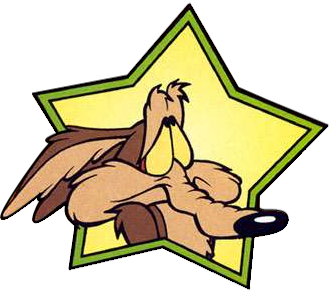
The Coyote is a bipedal coyote, a scrawny, hungry thing with scraggly brown fur and a crinkly muzzle. As his name suggests, he is sneaky and conniving, plotting and scheming endlessly to one day catch and eat his nemesis: The Road Runner. Despite his (allegedly) superior intellect and an endless supply of gadgets and dynamite from the ACME Corporation, his attempts result in humiliating failure at almost every turn. This is a result of his fanaticism, as Jones puts it, “[the Coyote] like all of us, at least some of the time, [...] persists in a course of action long after he has forgotten his original reasons for embarking on it”.
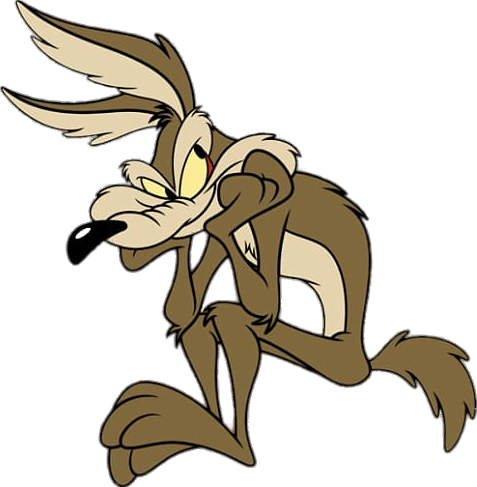
Initially, in the classic Road Runner shorts the Coyote is mute, however as early as the 1960s he had been given a snooty, pompous voice by Mel Blanc when pitted against Bugs Bunny. Blanc gives him an inconsistent yet in-character transatlantic accent, which was adopted and continued in every canonical instance of the Coyote in a spoken role. Various sounds and screams in the early cartoons are also provided by Mel Blanc.
Inspiration
The Coyote was heavily inspired by the Coyote from Mark Twain’s Roughing It, who was a sort of childhood friend of young bookworm Chuck Jones, further imbued with Jones’ understanding of himself. I believe through what I've read that there is much more of Jones within the Coyote than any other character, (yes, including Daffy Duck). That humanity applied to the character, I think, is what makes him compelling. Sure, it’s pathetic. But there’s something admirable about being blown up, crushed by boulders, run over by freight trains and running face-first into your own optical illusion painting and yet, continuing to give the chase one more try, if not for the reward of a meal, than on principle of catching that goddamned bird.
The Road Runner
“Road Runner is a primary character. He is a particular favorite of boys ages 3 to 7 years old who identify with his speed and hero-status while parents appreciate him because he is a winner.”
— The 1996 Style Guide for the Road Runner
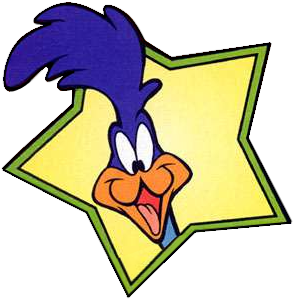
The Road Runner is a bright blue, bipedal flightless bird with deep blue head feathers and a sharp yellow beak. He is aloof, unbothered, and yet no stranger to the feeling of schadenfreude that comes with watching the Coyote’s plans backfire. He is characterised as somewhat of an innocent most of the time, simply observing the Coyote’s failures without necessarily causing them himself. That’s not to say he doesn’t have a mean streak, but who wouldn’t want to ensure the failure of the guy literally trying to kill and eat you?
That mean streak is most exacerbated in the mid-sixties, where he's written and played much more tricky and actively mean to the Coyote. This part of his character is really only present here, as in most cartoons he's just an innocent goof.
The classic Road Runner sound was recorded by animator Paul Julian, who went uncredited for a very long time due to the fact he was not a part of the Screen Actors Guild. According to other animators, Julian would make the sound to alert others as he would carry stuff down the studio hallways. Though the spelling that has stuck is “Beep-beep,” Julian’s preferred onomatopoeia was “hmeep hmeep" or "mweep, mweep" for the Road Runner Noise.
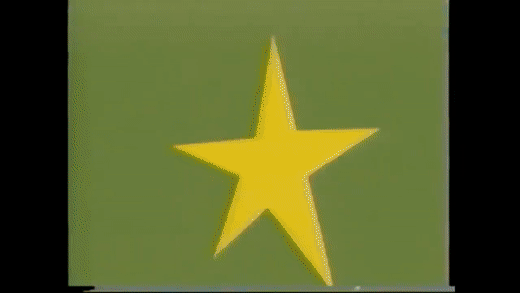
The Coyote and Road Runner have a straight-forward chase cartoon dynamic, which over the years has evolved somewhat depending on what makes the most sense when played alongside an ensemble cast (such as the Space Jam movies), or what is funniest in a short segment (such as this TV spot where they’re shown politely sharing a dressing room). They have also been featured together in many Looney Tunes comics. The series Beep Beep the Road Runner (published by Gold Key Comics) in which the Road Runner's name is Beep Beep and he has a wife and kids ran from the 60s through the 80s. They're also regular recurring characters in more modern DC Looney Tunes comics.
Something to note about the two of them as a pair is the fact that more often than not it's the Road Runner's name which takes the lead, such as the cartoon compilation block being called "The Road Runner Show" and the title of the Bugs Bunny/Road Runner Movie. This "top billing" of sorts is likely because the Road Runner is the primary comic hero of the duo: despite our sympathies resting with the Coyote and his plight, it is the Road Runner who ultimately wins out, and who ultimately recieves the attention and status as "primary character" in advertising and marketing material (as is seen in the style guides from the early 1990s).
In the Road Runner cartoons, we hoped to evoke sympathy for the Coyote. It is the basis of the series: the Coyote tries by any means to capture the Road Runner, ostensibly and at first to eat him, but his motive has become beclouded, and it has become, in my mind at least, a question of loss of dignity that forces him to continue. And who is the Coyote’s enemy? Why, the Coyote. The Road Runner has never touched him, never startled him intentionally beyond coming up behind the Coyote occasionally and going “Beep-Beep.”
Chuck Amuck: The Life and Times of an Animated Cartoonist, Chuck Jones, 223.
Other Opponents
The Road Runner isn't the Coyote's only adversary: in the 1950s and 60s, Bugs and Coyote were paired as opponents in five shorts: Operation: Rabbit, To Hare is Human, Rabbit's Feat, Compressed Hare, and Hare-Breadth Hurry. These shorts pit Bugs’ wits and penchant for absurdism against Coyote’s schemes and contraptions to a predictable end.
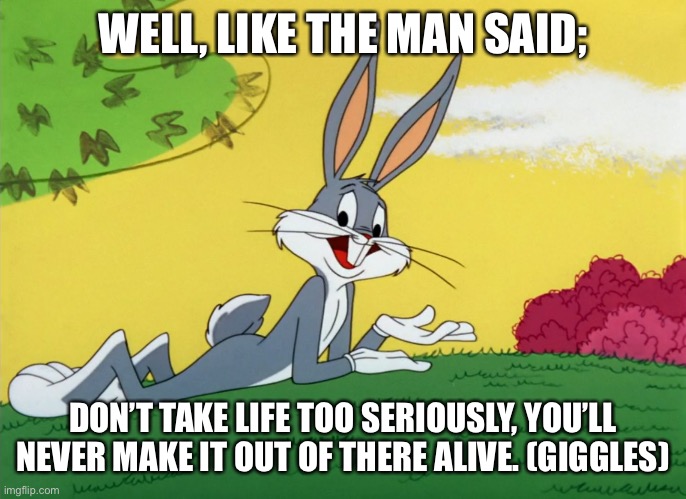
It can also be also be argued that maybe the real villain all along is the Acme Corporation. Acme, is in fact, not an acronym, but comes from the Greek “akme” which ironically means “peak.” It was added to company names in a strategic marketing ploy so as to be listed higher up alphabetically in the phonebook. The name is nowadays primarily associated with the Road Runner cartoons, as the Coyote’s supplier of choice from bird seed to military-grade weapons of mass destruction.
Speaking of the Acme Corporation, it is unclear as to what exactly the relationship between the Coyote and the brand is, exactly: due to the nature of the type of character the Coyote is, as he's been filtered through many different directors and envisioned in various cartoons I don't believe in taking Chuck Jones' word on it alone. Scandalous, I know. But the thing with Jones' writing I think gets lost in the idol worship of him (and admittedly I do think there is a lot to worship, don't get me wrong) is the fact that ultimately he is an unreliable narrator, and and a very opinionated one at that. All of these artist types are. His reported intension and the widely-circulated "rules" for these cartoons, even if they were true from conception (which as an artist myself I have to playfully doubt) they were reportedly not shared with the rest of his team.
This is why I take issue with some criticisms of the infamous Larriva Eleven, a series cartoons directed by Rudy Larriva at DePatie-Freling Enterprises after the initial shutdown of Warner Brothers Animation. They were thus subcontracted to a different, noticeably cheaper animation studio. The main criticisms of these cartoons is that they are cheap, ugly, long, not funny, and the music in them is annoying. And uh, with all due respect to the late Rudy Larriva, they are. However, those rules keep on coming up in discussions of these cartoons and despite their obvious lack of quality, I don't think that particular criticism is in good faith.
Other Associated Characters
Wile E. Coyote has been given both a protege and a descendant in the far far future in the form of Tiny Toon Adventures and Loonatics Unleashed.
Tiny Toon Adventures (1990-1992)
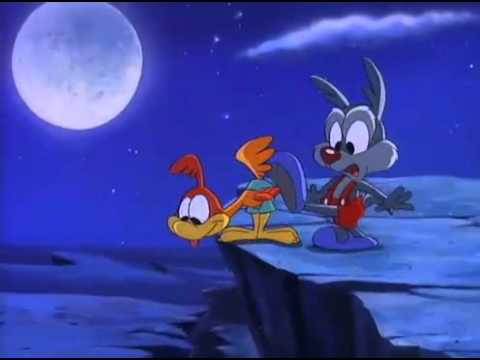
I’m going to be completely honest here and admit that I have no interest in the original Tiny Toons outside of seeing how they portrayed my favorite characters and their proteges. Calamity Coyote seems to follow the Coyote tradition of having a delightfully prophetic name and advanced intellect. He is also mute, communicating through written signs like Wile. Little Beeper, Road Runner’s protege is much more openly mocking to Calamity than their predecessors are to one-another. Neither are voiced, though Coyote himself is voiced by Joe Alaskey in a few episodes.
Calamity is also in Tiny Toons Looniversity where he is very cool and hardcore, in contrast to his very round cute design. He and Little Beeper have a few short scenes together. I'm pleased to say that Coyote himself features prominently in the episode "General Hogspital" with his own C plot. He's a professor of "science," and he communicates through body language and his classic picket signs.
Loonatics Unleashed (2005)
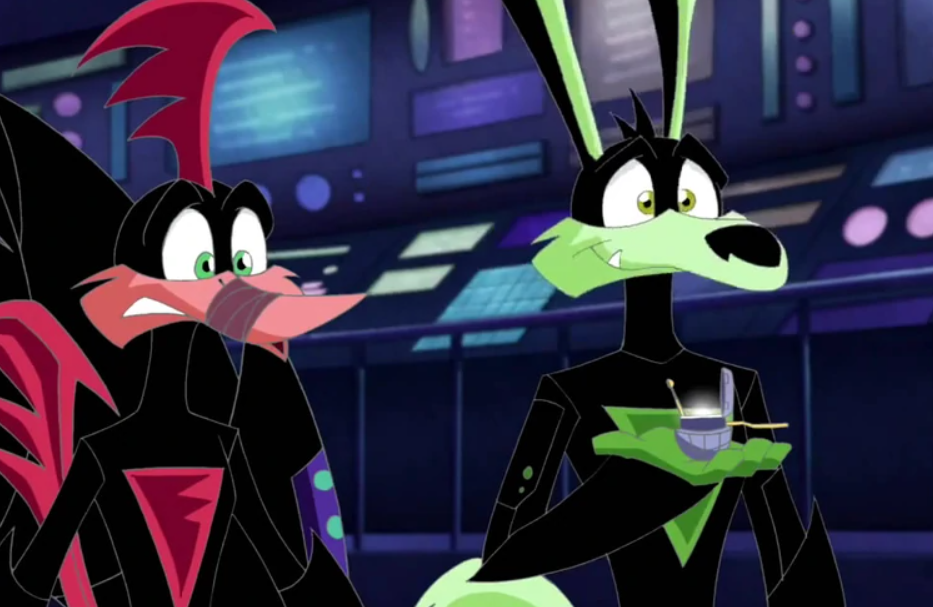
Much like how I found the original Tiny Toons unwatchable, I cannot watch Loonatics Unleashed. Which is a shame because the coyote character's theme color is green (my favorite color) and he's the Tech Guy who babies his inventions (a character type I always adore) in a cartoon meant to be cool and edgy like the original Teen Titans (which I loved!). So sad. Anyway; in the far-off future of the year 2772 the descendents of the Looney Tunes have to save the world from alien invasion and form a superhero team? Like I said, never watched it. But, it does feature the descendants of my boys in Tech E. Coyote, described as an “inventor” alongside the Road Runner's descendent Rev Runner. Tech is voiced by Kevin Micheal Richardson and Rev is voiced by Rob Paulson.
Other Family members
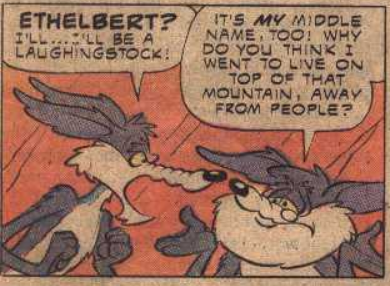
The "canon"-ness of the relatives given to Coyote and the Road Runner is a bit nebulous, and this can be said for all of the Looney Tunes and their family. There isn't a lot of consistency or communication across mediums from shorts, to show, to comic books so we wind up with a lot of different characters from different continuities. In the "Beep-Beep the Road Runner" comics, we see that the Road Runner has a wife named Matilda and three sons. The Coyote in these comics is revealed to be named after an uncle Ethelbert. As for the shorts, Coyote's father appears in Little Go Beep as an esteemed hunter himself. He has the similar punny name of Cage E. Coyote.
As mentioned, none of these characters exist outside the individual storylines they're a part of.
Interpretations
An interpretation of these cartoons which I really like is that of Wile E. Coyote as a continuation/modern evolution of the trickster spirit of coyote, a figure in different Native American oral traditions and folklore. Coyote (the animal, figure, or spirit) appears often as a sneaky teacher to man. If you would like to read into this, there is a fantastic article from 1998 called "When Coyote Leaves the Res: Incarnations of the Trickster from Wile E. to Le Guin" by Amanda Cockrell which discusses the way in which depictions of Coyote characters all link back to those original oral traditions.
Here is a collection of various other interpretations (I hesitate to even suggest that these are theories) for what the Coyote/Road Runner cartoons might mean, or rather, the kinds of speculation imposed on what is clearly a depiction of man’s folly and the fanaticism that comes with believing you are the one who will complete an impossible task. (You can probably tell by my tone that I don’t really like a lot of these lol)
- Wile E. Coyote is in Hell, Purgatory, Limbo, ect. and the Road Runner is God.
- This interpretation is portrayed humorously in the Supernatural episode 08x08 Hunter Heroici, in which the angel Castiel says "I understand. The bird represents God, Coyote is Man, endlessly chasing the divine and yet never able to catch Him," after very intensely and seriously studying the cartoons.
- The Coyote is an employee of the Acme Corporation. This one has a lot of conflicting interpretations based on what is most funny in the moment.
- “Whatever his needs were, the Acme Corporation was there to supply. It was a perfect symbiotic relationship; no money was ever involved.” -Chuck Amuck, page 223
- In Tiny Toons Adventures the Coyote references an “Acme Credit Card" while speaking to Calamity
- In Looney Tunes: Back in Action he seems to be employed by the chairman of the Acme Corporation as an "operative"
- The Road Runner is the CEO of the Acme Corporation. This one seems to be just for fun, as it's the subject of a Robot Chicken sketch.
- The pair have such an unhealthy codependent symbiotic relationship in that without one, the other’s life would have no meaning or purpose.
- The subject of two awful “comedy” sketches: one by Seth MacFarlane and one from Drawn Together: The Movie in which upon the Road Runner's death, the Coyote quickly spirals into a depression.
- I do think this could be funny and/or cute because they really do exist better together.
- The Road Runner is dead in the cartoons where Bugs and Coyote are paired together, because Coyote’s father told him not to speak until he had caught the bird.
- This lore drop is only mentioned in the cartoon Little Go Beep from 2000, which was created about forty-odd years after the Bugs Bunny/Coyote cartoons, and is not mentioned anywhere else.
- The Coyote wants to have sex with the Road Runner. I don’t like this one. No further comment.



